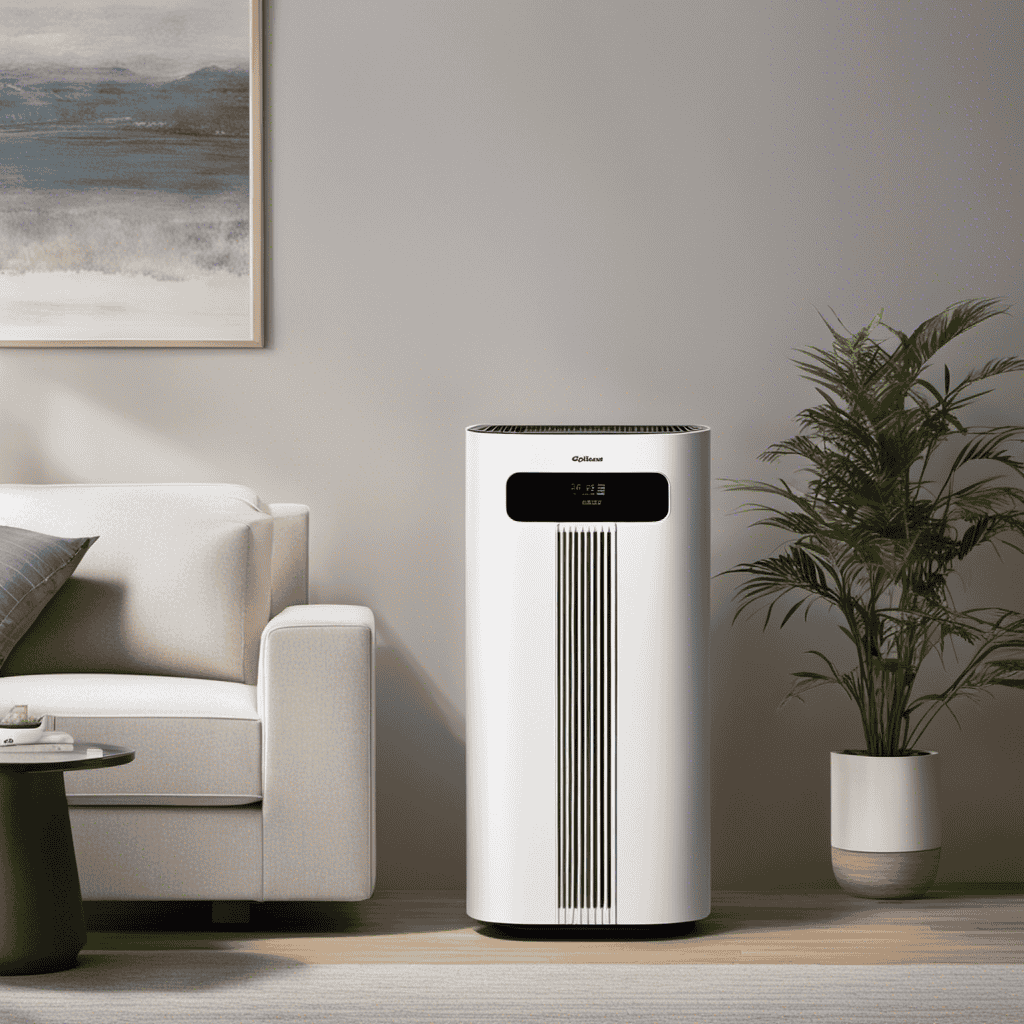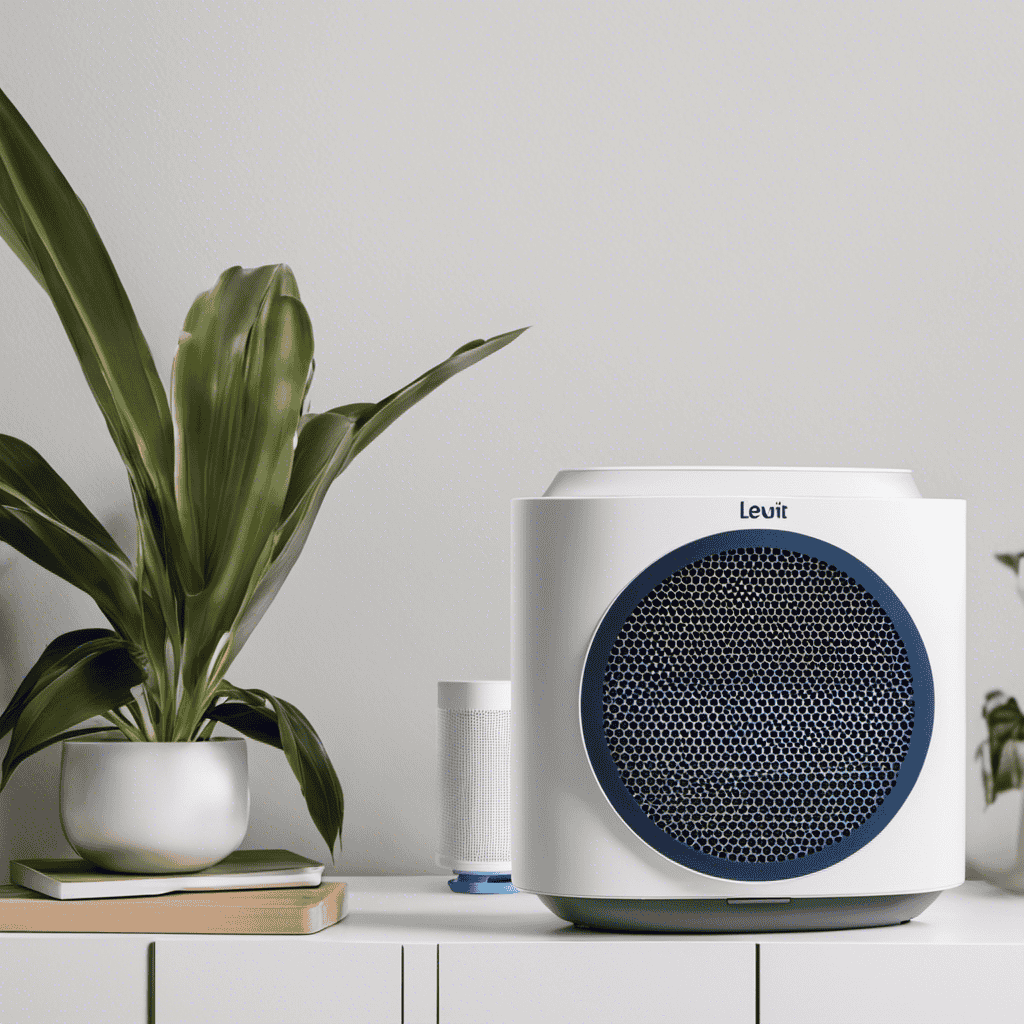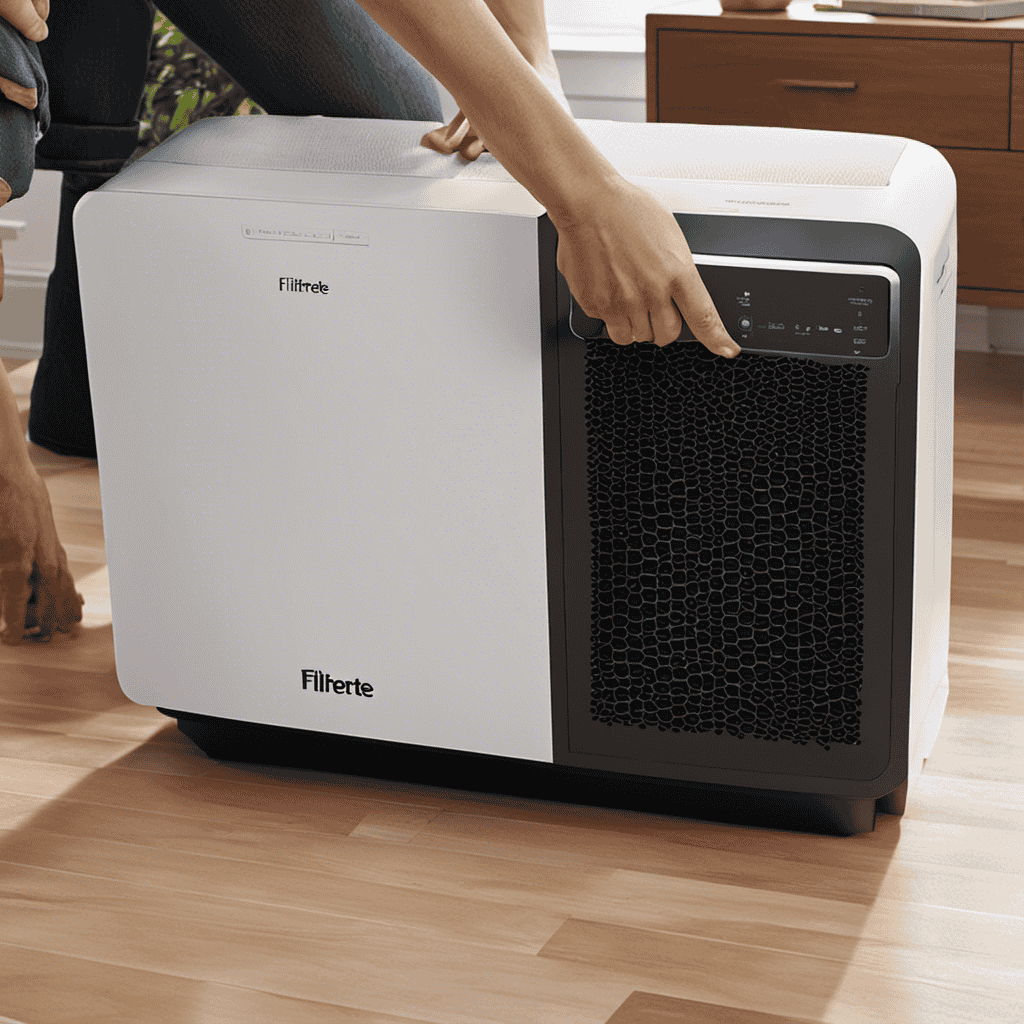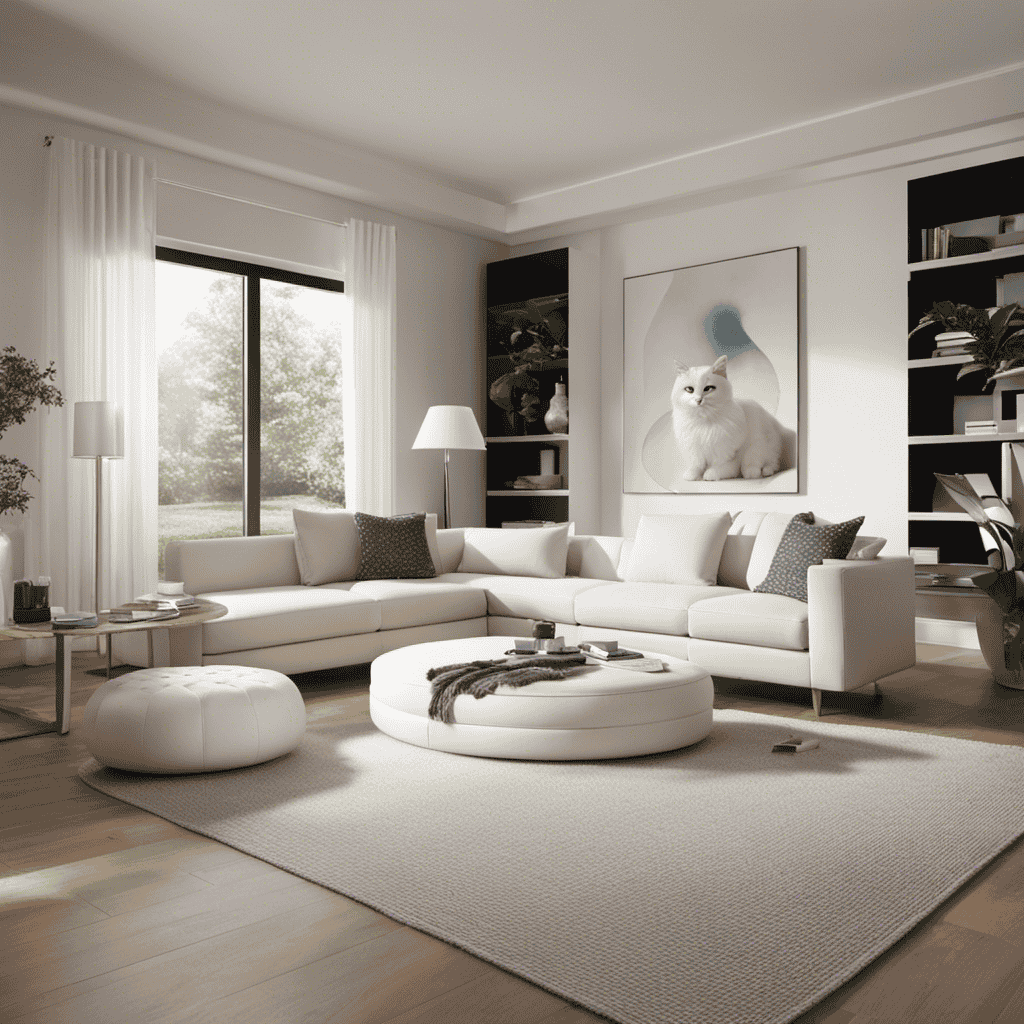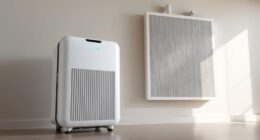Are you looking for the ideal air purifier to enhance the air quality in your home? Search no more!
In this article, I will guide you through the process of selecting the best air purifier that suits your needs. From understanding different types of air purifiers to evaluating filter efficiency and performance, I will provide you with evidence-based information to help you make an informed decision.
So, let’s dive in and explore how to choose the best air purifier for your home!
Key Takeaways
- Consider the room size and coverage area when choosing an air purifier.
- Look for air purifiers with effective filtration technologies such as HEPA filters and activated carbon filters.
- Take into account popular air purifier brands and customer reviews.
- Pay attention to features like powerful airflow, efficient HEPA filtration, quiet operation, and stylish design.
Different Types of Air Purifiers
When choosing an air purifier, you’ll want to consider the different types available. There are several air purifier brands on the market, each offering a variety of features to cater to your specific needs.
The most common types of air purifiers include HEPA filters, activated carbon filters, ozone generators, and UV germicidal lamps. HEPA filters are highly effective in removing allergens and particles as small as 0.3 microns. Activated carbon filters excel at eliminating odors and volatile organic compounds. Ozone generators produce ozone to neutralize odors and kill bacteria. UV germicidal lamps use ultraviolet light to destroy bacteria and viruses.
It’s important to carefully research and compare the features of different air purifier brands to find the one that best suits your needs and provides the cleanest air for your space.
Understanding Air Purification Technologies
When it comes to air purification technologies, understanding the different types of filters is crucial. Filter types, such as HEPA filters and activated carbon filters, play a significant role in removing various contaminants from the air.
Additionally, exploring the effectiveness of ionizers and the benefits of UV-C light can provide valuable insights into the overall air purification process.
Filter Types Explained
To choose the best air purifier, you should understand the different filter types available. There are several options to consider when it comes to air purifier filters, each with its own unique benefits. Here are four common filter types to help you make an informed decision:
-
HEPA Filters: These filters are highly effective at capturing airborne particles as small as 0.3 microns, including allergens, dust, and pet dander.
-
Activated Carbon Filters: These filters excel at removing odors and volatile organic compounds (VOCs) from the air. They work by adsorbing these chemicals onto the carbon surface.
-
UV Filters: UV filters use ultraviolet light to kill viruses, bacteria, and mold spores. However, they are not effective against larger particles or odors.
-
Pre-Filters: Pre-filters capture larger particles like hair and dust, preventing them from clogging the main filter and extending its lifespan.
Understanding the different filter options available will help you choose an air purifier that suits your specific needs. Now let’s discuss the effectiveness of ionizers in the next section.
Effectiveness of Ionizers
Ionizers are effective at removing particles from the air, but they do not have filters like other types of air purifiers. Unlike High Efficiency Particulate Air (HEPA) filters, which physically trap particles, ionizers use charged ions to attract and remove pollutants from the air.
These ions attach themselves to airborne particles, causing them to become heavy and fall to the ground or stick to surfaces. While ionizers are effective in reducing particle concentrations, they have some limitations.
Firstly, they do not remove gases, odors, or volatile organic compounds (VOCs) from the air. Additionally, ionizers produce ozone as a byproduct, which can be harmful to human health and the environment in high concentrations.
Therefore, when considering the long-term effects of ionizers, it is important to weigh their effectiveness in particle removal against potential risks associated with ozone generation.
UV-C Light Benefits
UV-C light is effective at killing bacteria and viruses in the air. It is one of the most powerful disinfection methods available for air purifiers. As someone who values cleanliness and germ-free environments, I have found UV-C light to be an excellent addition to my air purifier.
Here are four reasons why I believe in the germicidal properties of UV-C light:
-
Efficiency: UV-C light has been proven to kill up to 99.9% of airborne bacteria and viruses, including influenza and COVID-19.
-
Safety: While UV-C light is powerful, it is also safe to use in air purifiers. The light is contained within the unit and does not pose a risk to humans or pets.
-
Chemical-free: Unlike some disinfection methods, UV-C light does not require the use of chemicals or sprays, making it a more environmentally friendly option.
-
Continuous protection: Air purifiers with UV-C light provide continuous disinfection, ensuring that the air you breathe is consistently clean and free from harmful pathogens.
Factors to Consider Before Buying an Air Purifier
Before buying an air purifier, it’s important to consider factors such as room size and filtration technology. Room size determines the appropriate purifier size, ensuring optimal air cleaning efficiency. Filtration technology plays a crucial role in removing pollutants from the air. Some popular air purifier brands that offer advanced filtration systems include Dyson, Honeywell, and Blueair. To make an informed decision, I relied on customer reviews that provided valuable insights on the performance and reliability of these brands. After comparing the reviews, I found that Dyson air purifiers received positive feedback for their powerful airflow and smart features. Honeywell was praised for its efficient HEPA filtration, while Blueair stood out for its quiet operation and stylish design. Taking into account these factors and customer reviews, I was able to choose the best air purifier for my needs.
| Air Purifier Brand | Customer Reviews |
|---|---|
| Dyson | Positive |
| Honeywell | Efficient |
| Blueair | Quiet and stylish |
Choosing the Right Size and Coverage Area
When it comes to air purifiers, size plays a crucial role in determining their performance. A larger unit is typically more capable of effectively cleaning the air in a given space compared to a smaller one. However, it’s important to strike a balance between size and performance to ensure optimal air purification.
Additionally, when considering an air purifier for allergies, it is essential to choose a model that offers adequate coverage for the specific allergens you are targeting, such as pollen, pet dander, or dust mites.
Size Vs. Performance
To get the best air purifier for your needs, you’ll want to consider the trade-off between size and performance.
When it comes to size considerations, a smaller air purifier may be more convenient to move around and fit in smaller spaces, but it may have a lower Clean Air Delivery Rate (CADR) and coverage area. On the other hand, a larger air purifier may have a higher CADR and cover a larger area, but it may take up more space and be less portable.
When evaluating performance factors, pay attention to the CADR for different pollutants such as dust, pollen, and smoke. Additionally, consider the noise level and energy efficiency of the air purifier.
By finding the right balance between size and performance, you can ensure that you choose an air purifier that effectively improves your indoor air quality.
- Consider the size of the space where you plan to use the air purifier.
- Evaluate the Clean Air Delivery Rate (CADR) for different pollutants.
- Take into account the noise level of the air purifier.
- Consider the energy efficiency of the air purifier.
Coverage for Allergies
If you suffer from allergies, finding an air purifier with a wide coverage area is essential. Allergens can be present in the air throughout your home, and a purifier with a large coverage area ensures that you are protected in every room.
When considering air purifier brands, look for ones that have a high Clean Air Delivery Rate (CADR), as this indicates how quickly and effectively the purifier can remove pollutants from the air.
Additionally, it is important to maintain your air purifier properly to ensure optimal performance. Regularly cleaning or replacing filters, as recommended by the manufacturer, will help to keep your purifier running efficiently.
Evaluating the Filter Efficiency and Performance
Check out the filter efficiency and performance of different air purifiers to ensure you’re getting the best one for your needs. When evaluating air purifiers, it’s important to consider the noise levels and energy consumption.
Here are four key factors to consider:
-
Filter Efficiency: Look for air purifiers with high-efficiency particulate air (HEPA) filters. These filters can capture 99.97% of particles as small as 0.3 microns, including allergens, dust, and pet dander.
-
CADR Rating: Check the Clean Air Delivery Rate (CADR) of the purifier. This rating indicates how quickly the purifier can clean the air in a specific room size. Higher CADR means faster and more effective air purification.
-
Noise Levels: Consider the noise level produced by the air purifier, especially if you plan to use it in a bedroom or office. Look for models with a low noise level, typically below 50 decibels, for a peaceful environment.
-
Energy Consumption: Evaluate the energy consumption of the air purifier to ensure it won’t cause a significant increase in your electricity bill. Look for models with Energy Star certification, as they are designed to be energy-efficient.
Noise Level and Energy Consumption
Consider evaluating the noise level and energy consumption of different models to ensure you’re selecting one that suits your needs.
When it comes to air purifiers, energy efficiency and noise reduction are important factors to consider. Look for models that are ENERGY STAR certified, as they are designed to consume less energy while providing optimal performance. These models not only help you save on energy costs but also contribute to reducing your carbon footprint.
Additionally, pay attention to the noise level of the air purifier. Some models come with noise reduction technology, ensuring a quieter operation. This is especially important if you plan to use the air purifier in your bedroom or office.
Additional Features and Functions to Look for
When looking for an air purifier, it’s important to prioritize additional features and functions that suit your needs. Here are four key features to consider:
-
Smart technology: Choose an air purifier that can be controlled through your smartphone or smart home system. This allows you to monitor and adjust the settings remotely for convenience and ease of use.
-
Air quality sensors: Look for an air purifier with built-in sensors that can detect the quality of the air in your home. These sensors can measure the levels of pollutants and allergens and automatically adjust the purifier’s settings to provide optimal air purification.
-
Filter replacement indicators: It’s crucial to regularly replace the filters in your air purifier to maintain its effectiveness. Look for a purifier that has a filter replacement indicator, which will notify you when it’s time to change the filters, ensuring that your purifier continues to provide clean air.
-
Timer and scheduling options: Some air purifiers come with timer and scheduling features, allowing you to set specific times for the purifier to run. This can be helpful if you want the purifier to operate only during certain hours or when you’re not at home, saving energy and extending the life of the filters.
Comparing Portable Vs. Whole-House Air Purifiers
When comparing portable air purifiers to whole-house air purifiers, there are several key points to consider.
Firstly, let’s discuss the pros and cons of each option.
Portable air purifiers offer the advantage of being easy to move around and target specific areas, but they may not be as effective in purifying the air throughout an entire house.
On the other hand, whole-house air purifiers are more effective in covering a larger area, but they can be more expensive and require professional installation.
Pros and Cons
The pros of using an air purifier include reducing allergens and improving air quality, while the cons may include maintenance costs and noise levels.
When choosing the right model, it’s important to consider the following:
-
Size and Coverage: Look for an air purifier that can effectively clean the air in the room or area where you plan to use it. Consider the square footage and make sure the purifier is designed for that size.
-
Filtration System: Check the type of filters used in the purifier. High-quality models typically have multiple filters, including a HEPA filter for capturing small particles like dust, pollen, and pet dander.
-
Noise Levels: Some air purifiers can be noisy, especially at higher fan speeds. If noise is a concern, look for models with a noise-reducing feature or adjustable fan speeds.
-
Maintenance and Filter Replacement: Consider the cost and frequency of replacing the filters. Look for models with easily accessible filters and clear guidelines on when and how to replace them.
Cost and Effectiveness
Considering cost and effectiveness, it’s important to weigh the benefits of an air purifier against its potential drawbacks.
When it comes to air purifiers, affordability is a crucial factor to consider. Fortunately, there are cost-effective options available in the market that can effectively improve indoor air quality. These affordable air purifiers may not have all the advanced features of their higher-priced counterparts, but they can still efficiently remove airborne pollutants such as dust, pollen, and pet dander.
It’s essential to research and compare different models to find the best balance between price and performance. By doing so, you can ensure that you get the most value for your money while still achieving cleaner and healthier air in your home.
Now, let’s delve into the importance of CADR and ACH ratings in selecting the right air purifier.
The Importance of CADR and ACH Ratings
It’s important to pay attention to CADR and ACH ratings when choosing an air purifier. These ratings provide valuable information about the device’s ability to remove pollutants and improve indoor air quality. Here are four reasons why CADR and ACH ratings are crucial:
-
Efficiency: CADR (Clean Air Delivery Rate) measures how quickly and effectively an air purifier can remove specific pollutants from the air. Higher CADR ratings indicate better performance.
-
Coverage: ACH (Air Changes per Hour) quantifies how many times an air purifier can filter the entire room’s air in an hour. Higher ACH ratings indicate more thorough air purification.
-
Compliance: CADR and ACH ratings help ensure that air purifiers meet air quality standards set by organizations like the Association of Home Appliance Manufacturers. This ensures that you invest in a reliable and effective device.
-
Health benefits: Choosing an air purifier with high CADR and ACH ratings means you can breathe cleaner air, reducing the risk of respiratory issues and allergies.
Understanding Maintenance and Filter Replacement
Understanding how often to perform maintenance and replace filters is essential for keeping your air purifier running efficiently. Regular maintenance ensures that your purifier continues to effectively remove pollutants from the air, providing you with clean and fresh indoor air quality. When it comes to filter replacement, the frequency will depend on various factors such as the type of filter, the level of air pollution in your area, and the manufacturer’s recommendations. Below is a table that outlines general guidelines for filter replacement based on filter types:
| Filter Type | Recommended Replacement Frequency |
|---|---|
| HEPA | Every 6-12 months |
| Carbon | Every 3-6 months |
| Pre-filter | Every 1-3 months |
What Factors Should I Consider When Choosing an Air Purifier?
When selecting the best air purifier, consider the size of the room you want to purify, the type of pollutants you want to eliminate, and your budget. Look for a purifier with a HEPA filter, a high CADR rating, and a low noise level to improve air quality effectively.
Tips for Buying an Air Purifier on a Budget
Now, let’s explore some tips for purchasing an air purifier on a budget.
-
Consider budget-friendly options: Look for air purifiers that offer good performance at a lower price point. There are many affordable models available that can effectively remove pollutants from the air.
-
Research different brands and models: Take the time to compare various air purifiers to find the best value for your money. Look for reviews and ratings to ensure you’re getting a reliable product.
-
Look for discounts and sales: Keep an eye out for promotions and discounts that can help you save money on your purchase. Many retailers offer sales throughout the year, so be patient and wait for the right opportunity.
-
Consider buying second-hand: If you’re on a tight budget, purchasing a second-hand air purifier can be a cost-effective option. Just make sure to thoroughly check the condition and performance of the unit before making a purchase.
Frequently Asked Questions
What Are the Potential Health Benefits of Using an Air Purifier?
Using an air purifier can potentially improve sleep and reduce respiratory symptoms. It filters out allergens, pollutants, and toxins from the air, creating a cleaner and healthier environment for breathing.
How Often Should I Run My Air Purifier?
I typically run my air purifier for about 8-12 hours a day, depending on the air quality in my home. It’s important to consider the cost of running the purifier, as well as the recommended brands for optimal performance.
Can an Air Purifier Remove Odors From My Home?
Yes, an air purifier can remove odors from your home. Using advanced air purifier technology, different types of air purifiers, such as activated carbon filters, effectively capture and eliminate unpleasant odors, leaving your home smelling fresh and clean.
Are Air Purifiers Effective in Reducing Allergens?
Air purifiers are effective in reducing allergens. They efficiently remove airborne particles like pollen, dust mites, and pet dander, improving indoor air quality. It’s important to choose a purifier with a HEPA filter for maximum effectiveness.
Do Air Purifiers Require Any Special Installation or Maintenance?
Air purifiers do not require any special installation but regular maintenance is necessary. Filters need to be replaced periodically to ensure optimal performance. Noise levels vary depending on the model.
Conclusion
In conclusion, choosing the best air purifier requires careful consideration of various factors. These factors include the type of purifier, technology used, size and coverage area, filter efficiency, and maintenance requirements.
One interesting statistic to note is that, according to a study conducted by the Environmental Protection Agency (EPA), indoor air can be up to five times more polluted than outdoor air. This statistic highlights the importance of investing in a high-quality air purifier to improve the air quality in your home or office.
Make an informed decision and enjoy cleaner and healthier air!
